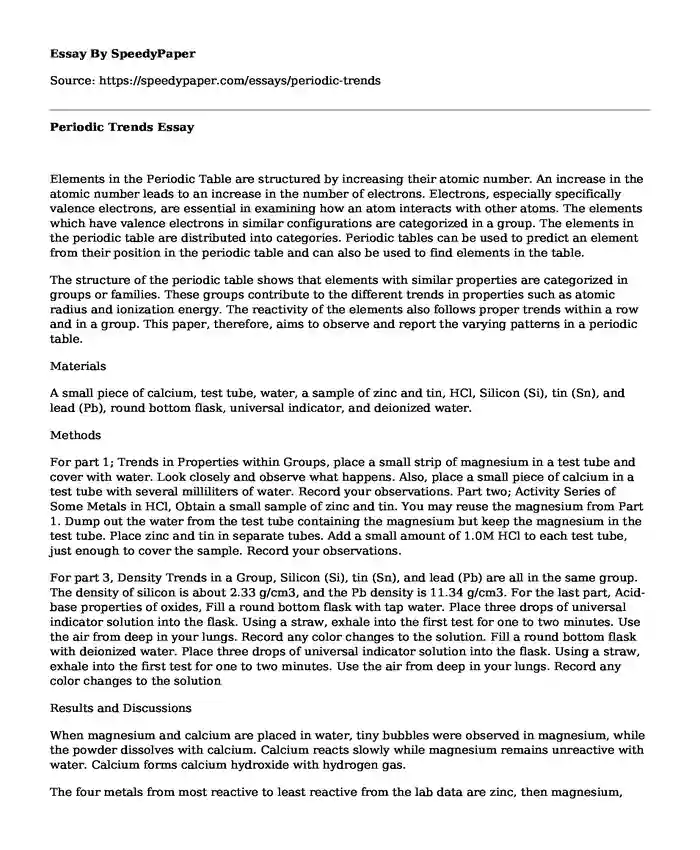
| Type of paper: | Essay |
| Categories: | Company Law Philosophy War Accounting |
| Pages: | 3 |
| Wordcount: | 694 words |
Elements in the Periodic Table are structured by increasing their atomic number. An increase in the atomic number leads to an increase in the number of electrons. Electrons, especially specifically valence electrons, are essential in examining how an atom interacts with other atoms. The elements which have valence electrons in similar configurations are categorized in a group. The elements in the periodic table are distributed into categories. Periodic tables can be used to predict an element from their position in the periodic table and can also be used to find elements in the table.
The structure of the periodic table shows that elements with similar properties are categorized in groups or families. These groups contribute to the different trends in properties such as atomic radius and ionization energy. The reactivity of the elements also follows proper trends within a row and in a group. This paper, therefore, aims to observe and report the varying patterns in a periodic table.
Materials
A small piece of calcium, test tube, water, a sample of zinc and tin, HCl, Silicon (Si), tin (Sn), and lead (Pb), round bottom flask, universal indicator, and deionized water.
Methods
For part 1; Trends in Properties within Groups, place a small strip of magnesium in a test tube and cover with water. Look closely and observe what happens. Also, place a small piece of calcium in a test tube with several milliliters of water. Record your observations. Part two; Activity Series of Some Metals in HCl, Obtain a small sample of zinc and tin. You may reuse the magnesium from Part 1. Dump out the water from the test tube containing the magnesium but keep the magnesium in the test tube. Place zinc and tin in separate tubes. Add a small amount of 1.0M HCl to each test tube, just enough to cover the sample. Record your observations.
For part 3, Density Trends in a Group, Silicon (Si), tin (Sn), and lead (Pb) are all in the same group. The density of silicon is about 2.33 g/cm3, and the Pb density is 11.34 g/cm3. For the last part, Acid-base properties of oxides, Fill a round bottom flask with tap water. Place three drops of universal indicator solution into the flask. Using a straw, exhale into the first test for one to two minutes. Use the air from deep in your lungs. Record any color changes to the solution. Fill a round bottom flask with deionized water. Place three drops of universal indicator solution into the flask. Using a straw, exhale into the first test for one to two minutes. Use the air from deep in your lungs. Record any color changes to the solution
Results and Discussions
When magnesium and calcium are placed in water, tiny bubbles were observed in magnesium, while the powder dissolves with calcium. Calcium reacts slowly while magnesium remains unreactive with water. Calcium forms calcium hydroxide with hydrogen gas.
The four metals from most reactive to least reactive from the lab data are zinc, then magnesium, then calcium, and finally, tin as the least reactive. There is a relationship between the location of metals and their relative reactivity because elements at the top of the periodic table tend to react more, while those at the bottom or with metalloid boundary do not react much.
The estimate based on the density of tin is 3.15g/cm3.
Mass of sample = 1.9712258 10^-22 g
Volume of water before adding sample = 2cm3
Volume of water after adding sample = 4cm3
Volume of sample of tin = 2cm3
Density of tin, D= M/V
= 1.9712258 10^-22 g / 2cm3
= 9.856x 10-23 g/cm3
When elements are organized in the periodic table, various trends appear. These trends include: from left to right, elements on the left are more reactive than elements on the right. The more you go up a column, the higher the elements are reactive. Also, from left to right on the periodic table, oxides go from basic to acidic.
Conclusion
In conclusion, this experiment evaluates the patterns and trends in the periodic table and how elements reactive with different substances. The elements in the periodic table are indeed organized according to their reactions.
Cite this page
Periodic Trends. (2023, Aug 14). Retrieved from https://speedypaper.net/essays/periodic-trends
Request Removal
If you are the original author of this essay and no longer wish to have it published on the SpeedyPaper website, please click below to request its removal:
- Financial Reporting - Lease Accounting. Free Essay Example.
- Essay Sample: International Criminal Court Pros and Cons
- Free Essay about Counseling: Questions about the Final Session
- Book Review Essay Sample: The Disability Rights Movement: From Charity to Confrontation
- Research Proposal Paper Sample: Trafficking for Organ Trade
- Essay Sample on Recruitment: Finding the Perfect Employee for Your Company
- Free Essay Sample: Carl Marx
Popular categories




